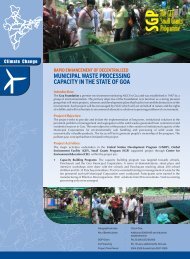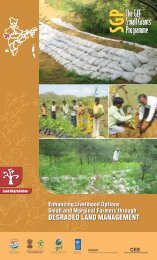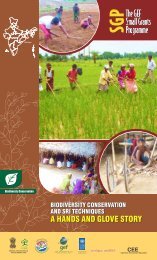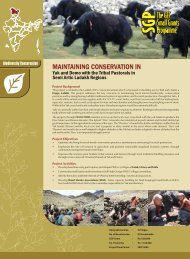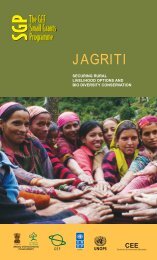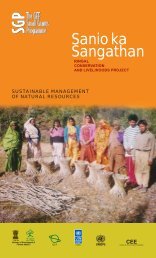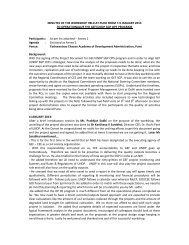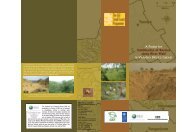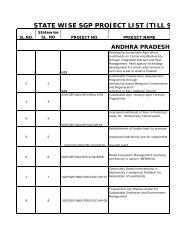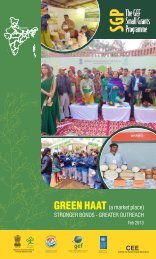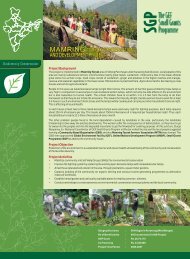COUNTRY INDIA
Country Programme Landscape Strategy - SGP India
Country Programme Landscape Strategy - SGP India
You also want an ePaper? Increase the reach of your titles
YUMPU automatically turns print PDFs into web optimized ePapers that Google loves.
Beekeeping, dairying, and cultivation of traditional food crops, including such traditional<br />
practices as the system of Barahnaja (see box on following page), should be renewed with the<br />
aim of providing food security and meeting nutrition needs of even poorer families. Traditional<br />
cropping practices in the region are also found viable to be pursued on small holdings of land.<br />
Traditional Farming Practice in Uttarakhand<br />
"The advanced nature of traditional farming in the region is illustrated by the practice of barahnaja (literally,<br />
'12 seeds'). This is the name of a sophisticated intercropping system of rainfed hill farming.<br />
Mandua (finger millets), ramdana/chua (amaranthus), rajma (common kidney beans), ogal (buckwheat), urad<br />
(green gram), moong (black gram), naurangi (mix of pulses), gahath (horsegram), bhat (soybean),<br />
lobiya (French beans) kheera (cucumber), bhang (cannabis), and other crops, are grown together in a mixture<br />
which is finely balanced to optimize productivity and maintenance of soil fertility, and is geared towards<br />
meeting diverse household requirements. In such traditional cultivation, farmers had to spend almost nothing on<br />
inputs, since seeds, organic fertilizer, and pest control were virtually free. Whenever they realized that<br />
conditions were suitable, they would start planting..."<br />
from Jardhari & Kothari 1997<br />
Source: http://uttarakhand.prayaga.org/agriculture.html<br />
2. Address decline of agricultural productivity: As stated earlier, pursuit of agriculture that is the<br />
mainstay for most families has stopped being profitable 8 over time. This is due to factors such as, (i)<br />
fragmentation of landholdings through division of inheritance across generations, (ii) falling yields<br />
from soil and water degradation, especially in light of accelerating climate change, (iii) market<br />
competitiveness tending to castigate inefficient performers, due to poor infrastructure and resultant<br />
input/output delivery inefficiencies, (iv) the national research and extension system largely focusing on<br />
the needs of irrigated farmers on the plains over the needs of poor rainfed hill farmers, (v) threats from<br />
wild animals such as wild boar, monkey, elephants, and Nilgai (Boselaphus tragocamelus) – an<br />
antelope also known as Blue Bull in some parts of the world (see picture alongside), (vi) breakdown of<br />
integrated farming approaches, specifically the decline of dairy production and reduction in bee<br />
populations, and (vii) shortage of labor due to out-migration, and increasing dependence on seasonal<br />
migrants with added costs.<br />
While there has been a talk over the last decade about diversification, there is little to be seen by<br />
way of success through animal husbandry, horticulture, or medicinal herbs; though to be fair,<br />
success stories in pockets can be seen but not to the scale that the state’s neighbour to the west,<br />
Himachal Pradesh has demonstrated. It is also important that policy support for agriculture in hill<br />
regions be given importance considering, (i) unique food needs of hill communities where<br />
specific crops can only be grown in similar landscapes, (ii) cost of delivering food to remote<br />
areas, and (iii) logistical difficulties particularly in the event of a disaster.<br />
It would thus be very important to pursue sustainable agriculture from a livelihood and food<br />
security perspective. Given the community’s deeper understanding of ecosystems and<br />
biodiversity, COMDEKS will do well to reinforce this latent sentiment and rekindle practices to<br />
8 While agriculture in general is suffering sustainable agriculture has little chance of being adopted unless it holds a meaning in<br />
the short term that translates to profitability. The pursuit to improve yield has wreaked havoc with soil and water resource<br />
and also made agriculture a loss bearing activity for the poor. As is known, in India while agriculture is the primary form of<br />
rural livelihood it is largely practiced on a subsistence basis and today can’t even meet an entire year’s need of most families.<br />
Yet it is being pursued towards abandonment on account of its cultural importance and lack of alternatives available in the<br />
rural landscape, or lack of skill to pursue other options. This also is the primary cause of migration. In the hills remittance<br />
from one migrant earning member in the family constitutes the largest income source. As such there is a need to make<br />
agriculture meaningful not only from an economic point of view but also as a gainful livelihood occupation.<br />
COMDEKS <strong>INDIA</strong> Page 17 of 22



